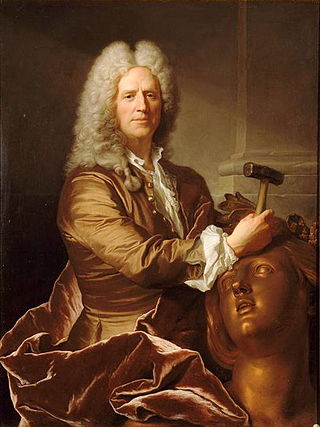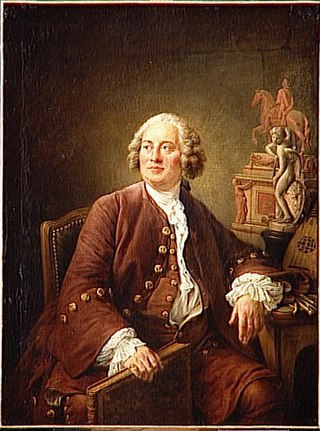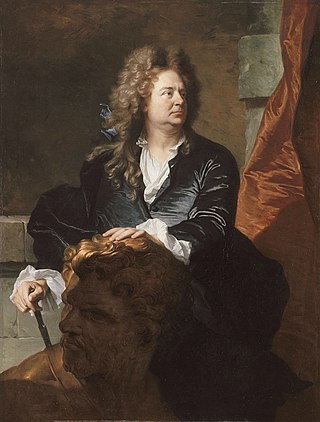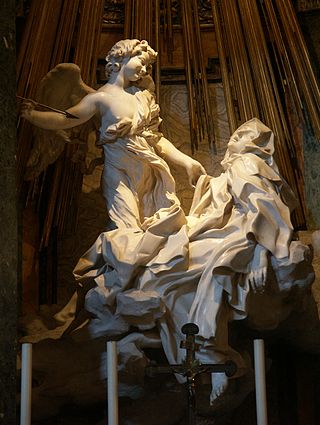
Jacint Rigau-Ros i Serra, known in French as Hyacinthe Rigaud, was a Catalan-French baroque painter most famous for his portraits of Louis XIV and other members of the French nobility.

Charles Le Brun was a French painter, physiognomist, art theorist, and a director of several art schools of his time. He served as a court painter to Louis XIV, who declared him "the greatest French artist of all time". Charles was a dominant figure in 17th-century French art and was influenced by Nicolas Poussin.

François Girardon was a French sculptor of the Louis XIV style or French Baroque, best known for his statues and busts of Louis XIV and for his statuary in the gardens of the Palace of Versailles.

Nicolas Coustou was a French sculptor and academic.

Guillaume Coustou the Elder was a French sculptor of the Baroque and Louis XIV style. He was a royal sculptor for Louis XIV and Louis XV and became Director of the Royal Academy of Painting and Sculpture in 1735. He is best known for his monumental statues of horses made for the Chateau of Marly, whose replicas now stand in the Place de la Concorde in Paris.

Jean-Baptiste Lemoyne was a French sculptor of the 18th century who worked in both the rococo and neoclassical style. He made monumental statuary for the Gardens of Versailles but was best known for his expressive portrait busts.

Edmé Bouchardon was a French sculptor best known for his neoclassical statues in the gardens of the Palace of Versailles, his medals, his equestrian statue of Louis XV of France for the Place de la Concorde ; and for the Fountain of Four Seasons in Paris. He was also a draftsman and painter, and made celebrated series of engravings of working-class Parisians.

The Louis XV style or Louis Quinze is a style of architecture and decorative arts which appeared during the reign of Louis XV. From 1710 until about 1730, a period known as the Régence, it was largely an extension of the Louis XIV style of his great-grandfather and predecessor, Louis XIV. From about 1730 until about 1750, it became more original, decorative and exuberant, in what was known as the Rocaille style, under the influence of the King's mistress, Madame de Pompadour. It marked the beginning of the European Rococo movement. From 1750 until the King's death in 1774, it became more sober, ordered, and began to show the influences of Neoclassicism.

Étienne Le Hongre was a French sculptor, part of the team that worked for the Bâtiments du Roi at Versailles. Le Hongre was one of the first generation of sculptors formed by the precepts of the Académie royale de peinture et de sculpture. At the Bain des Nymphes (1678–80) he was one of the sculptors providing lead bas-reliefs for the fountain setting that featured the work of François Girardon. Le Hongre provided other bronze figures for the Parterre d'Eau.

Martin Desjardins, born Martin van den Bogaert was a French sculptor and stuccoist of Dutch birth.

Jean-Baptiste Tuby was a French sculptor of Italian origins, best known for the sculpture in the fountains of the Gardens of Versailles. His work expresses the exuberance of the Baroque blended with the classicism of the Louis XIV style.

Baroque sculpture is the sculpture associated with the Baroque style of the period between the early 17th and mid 18th centuries. In Baroque sculpture, groups of figures assumed new importance, and there was a dynamic movement and energy of human forms—they spiralled around an empty central vortex, or reached outwards into the surrounding space. Baroque sculpture often had multiple ideal viewing angles, and reflected a general continuation of the Renaissance move away from the relief to sculpture created in the round, and designed to be placed in the middle of a large space—elaborate fountains such as Gian Lorenzo Bernini‘s Fontana dei Quattro Fiumi, or those in the Gardens of Versailles were a Baroque speciality. The Baroque style was perfectly suited to sculpture, with Bernini the dominating figure of the age in works such as The Ecstasy of St Theresa (1647–1652). Much Baroque sculpture added extra-sculptural elements, for example, concealed lighting, or water fountains, or fused sculpture and architecture to create a transformative experience for the viewer. Artists saw themselves as in the classical tradition, but admired Hellenistic and later Roman sculpture, rather than that of the more "Classical" periods as they are seen today.

Sebastiaen Slodtz, in France called Sébastien Slodtz (1655–1726) was a Flemish sculptor and decorator who after training in his native Antwerp, moved to France where he became a court sculptor to the King. He was the father of three sons who helped further shape official French sculpture between the Baroque and the Rococo.

Jacques Prou (1655–1706) was a French Academic Baroque sculptor, a product of the Academy system overseen by Charles Le Brun. Trained in the Academy school in Paris. he spent four years (1676–80) refining his style at the French Academy in Rome, then returned to Paris to become a member of the team of the Bâtiments du Roi from 1681, providing sculpture for Versailles in the atelier of Jean-Baptiste Tuby, whose daughter he married. He was received as a full member of the Académie royale de peinture et de sculpture in 1682, presenting as his reception piece a bas-relief of Sculpture consulting Painting over the portrait of Louis XIV, now at the Musée du Louvre, which reveals his concern for surface textures adapted from the dominant art, painting At Versailles he became closely associated in projects for fountains and emblematic decorative sculpture with Antoine Coysevox, notably in the Escalier des princes, the salon opening onto it, and the Salon de la Guerre.

Louis Lerambert was a French sculptor in a Parisian family that included four generations of court artists. who in 1637 inherited the court position caring for the Antiquities and Marbles of the King, which had become hereditary in his family. He trained in the atelier of Simon Vouet, recently returned from Rome; there he met the sculptor Jacques Sarazin.

Pierre Granier was a proficient but minor French sculptor, trained in the excellent atelier of François Girardon who produced a generation of highly competent sculptors for the Bâtiments du Roi. Granier served as a modest member of the extensive team that provided sculpture for the Château de Versailles and its gardens. Strict control over the subjects, scale, materials and to a great extent the design of sculpture for Versailles was exercised by the premier peintre du Roi, Charles Le Brun. According to Antoine-Nicolas Dézallier d'Argenville, Le Brun provided a wax model for Granier's marble group Ino and Melicertes, and a Shepherdess was sculpted after a sketch given by Le Brun.

The Galerie d'Apollon is a large and iconic room of the Louvre Palace, on the first (upper) floor of a wing known as the Petite Galerie. Its current setup was first designed in the 1660s. It has been part of the Louvre Museum since the 1790s, was completed under the lead of Félix Duban in the mid-19th century, and has housed the museum's collection of the French Crown Jewels since 1887.

The Equestrian Statue of King Louis XIV is a sculpture designed and partially executed by the Italian artist Gian Lorenzo Bernini, who was originally brought to France to design a new facade of the Louvre, a portrait bust, and an equestrian statue. Bernini first discussed the project while in France in the mid-1660s, but it did not start until later in the decade, when back in Rome. It was not completed until 1684 and then shipped to Paris in 1685. Louis XIV of France was extremely unhappy with the end result and had it placed in a corner of the gardens of the royal palace at Versailles. Soon after, the sculpture was modified by François Girardon and altered into an equestrian sculpture of the ancient Roman hero Marcus Curtius.

The Louis XIV style or Louis Quatorze, also called French classicism, was the style of architecture and decorative arts intended to glorify King Louis XIV and his reign. It featured majesty, harmony and regularity. It became the official style during the reign of Louis XIV (1643–1715), imposed upon artists by the newly established Académie royale de peinture et de sculpture and the Académie royale d'architecture. It had an important influence upon the architecture of other European monarchs, from Frederick the Great of Prussia to Peter the Great of Russia. Major architects of the period included François Mansart, Jules Hardouin Mansart, Robert de Cotte, Pierre Le Muet, Claude Perrault, and Louis Le Vau. Major monuments included the Palace of Versailles, the Grand Trianon at Versailles, and the Church of Les Invalides (1675–1691).

French sculpture has been an original and influential component of world art since the Middle Ages. The first known French sculptures date to the Upper Paleolithic age. French sculpture originally copied ancient Roman models, then found its own original form in the decoration of Gothic architecture. French sculptors produced important works of Baroque sculpture for the decoration of the Palace of Versailles. In the 19th century, the sculptors Auguste Rodin and Edgar Degas created a more personal and non-realistic style, which led the way to modernism in the 20th century, and the sculpture of Pablo Picasso, Georges Braque, Marcel Duchamp and Jean Arp.




















